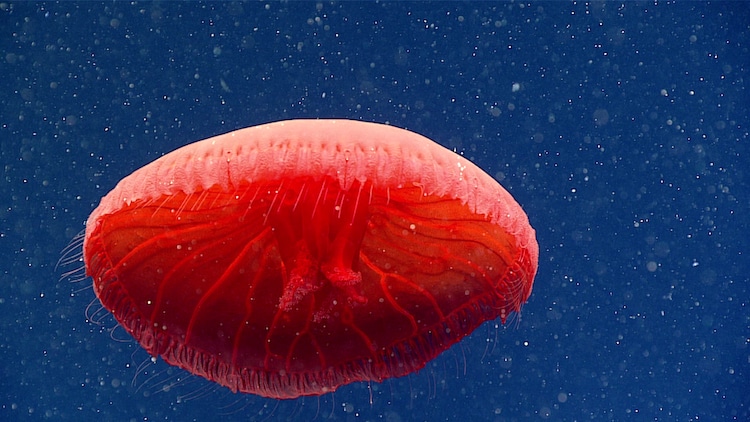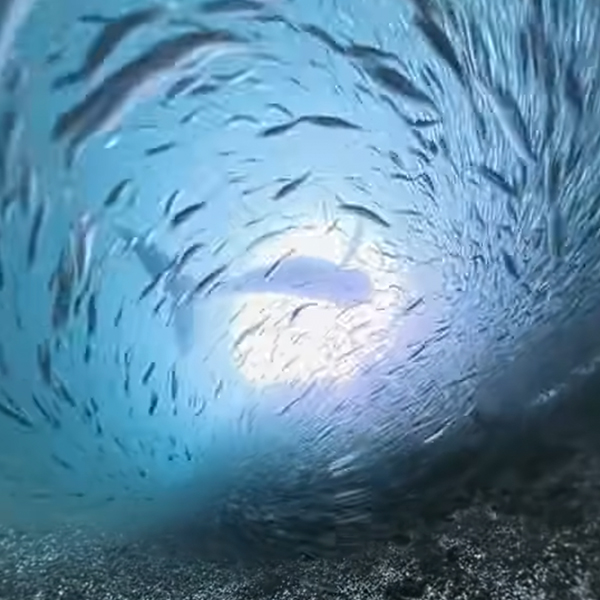
For 20 years, the National Oceanic and Atmospheric Administration (NOAA) has been exploring the deep oceans that surround the United States. Their expeditions help them find valuable information that fills in the gaps about what we know in regards to life in the deep sea. A recent expedition off the coast of New England uncovered a possible new species of jellyfish, proving the value of these trips.
About 100 miles southeast of Nantucket, the Hydrographer Canyon is rich in ocean life. It connects shallow waters to the deep parts of the ocean and has depths that range from 1,900 feet at the shallow end up to 4,668 feet at the shelf break. This was the location of several dives during the 2021 North Atlantic Stepping Stones: New England and Corner Rise Seamounts expedition. Using remotely operated vehicles (ROV), researchers were able to map the ocean floor and observe everything from deep-sea coral to ecosystems living in unexplored areas.
One of the incredible finds was a red jellyfish from the Poralia genus. NOAA states that it may be an undescribed species, which means that it was never given a scientific name and is unknown to scientists. The jellyfish was found swimming at a depth of 2,297 feet and the resulting photograph captures its spectacular red bell opening as it floats around.

A total of four samples were collected during Dive 20 of the 2021 North Atlantic Stepping Stones expedition using the suction sample on remotely operated vehicle (ROV) Deep Discoverer. Here, Global Foundation for Ocean Exploration ROV pilots deftly maneuvers to collect a potential new species of jellyfish during the 1200-meter (3,937-foot) dive transect.
Quinn L. Girasek was the lucky intern was who charged with observing and annotating the discoveries that the ROV brought to light. This included noting the specimens that the Deep Discoverer ROV sucked into one of its five collection jars for close examination later on. “I also took notes of potentially new and/or undescribed species,” she writes. “That was definitely a highlight and I can’t wait until we learn more about those organisms! If you go into SeaTube and filter by the words ‘collect' and ‘new' then you’ll be able to go directly to the portions of the videos where we saw those organisms. Besides the viperfish, two of my favorites from this dive are the ctenophore, genus Vampyroctena, and the cnidaria, genus Solmissus.”
It's incredible to think of how much we still don't know about the deep ocean and how many species, like the red jellyfish, are just waiting to be discovered.
Besides the red jellyfish, here are some other incredible observations made in the deep waters off the coast of New England by NOAA.

This viperfish was imaged during the 700-meter (2,297-foot) transect to explore the water column above Hydrographer Canyon during Dive 20 of the 2021 North Atlantic Stepping Stones expedition.

A close look at a larvacean house, seen during the 1200-meter (3,937-foot) water column transect of Dive 20 of the 2021 North Atlantic Stepping Stones expedition. Larvaceans are solitary, free-swimming tunicates that produce a fragile mucus “house” to help filter small particles from the water. A diffuse outer filter catches larger particles that would be too big to fit in the larvacean’s mouth and protects an inner filter, which is used to strain food particles from the water. The larvacean lives nested inside this inner filter and produces a current by beating its tail. This current both keeps the house inflated and moves water through the filter of the house.

A spiraled Iridiogorgia fontanalis coral seen next to an Acanella arbuscula bamboo coral. Seen during Dive 09 of the expedition near the upper summit of a carbonate platform on Yakatut Seamount, this was only the second time this species of Iridiogorgia has ever been observed.

The robotic arm of the remotely operated vehicle Deep Discoverer collects a glass sponge off the rocky slope of the Rockaway Seamount.
NOAA Ocean Exploration: Website | Facebook | Instagram
All images via NOAA Ocean Exploration, 2021 North Atlantic Stepping Stones: New England and Corner Rise Seamounts.
Related Articles:
Celebrate the Mysterious Beauty of Jellyfish With These Colorful Umbrellas
Watch Penguins, Jellyfish, and More via This Aquarium’s Free Live Streams
5 Critically Endangered Species and How You Can Help Protect Them
The First Underwater Museum in the Mediterranean Is Now Open in Cyprus






















































































